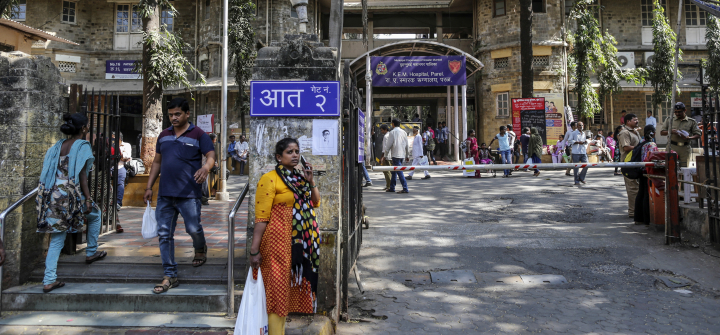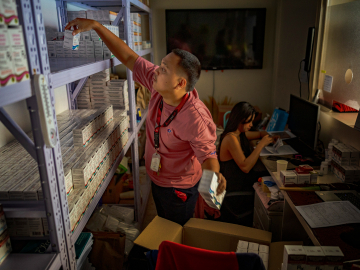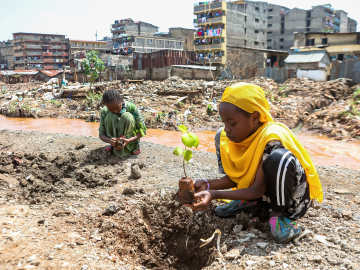Inside India’s Funding Failure in Rare Genetic Disease Care
On February 20, 3-year-old Arohi Kajabe died at home in Maharashtra’s Ahmednagar district after waiting for more than two years for medicines that never came.
Her father, Yogesh Kajabe, a daily-wage farm laborer who plants cotton and soybeans, had sold his only piece of land and borrowed more than $6,000 to keep her alive.
Arohi had Gaucher’s disease, a rare genetic disorder that silently destroys vital organs. Two injections every month could have saved her life—but each cost $1,200.
“My only child died before my eyes because I couldn’t afford the medicines,” Kajabe says, sitting on the mud floor of his hut.
Her death was even more painful because India’s government had allocated up to $60,000 per rare disease patient for treatment. But the Ministry of Health and Family Welfare didn’t approve the hospital’s funding request, so the money—and treatment—never arrived.
Just 30% of such applications are approved, a senior doctor says, leaving most patients without access to lifesaving medicines. But even the fortunate ones who secured such approvals find that expensive medicines can quickly exhaust the $60,000 spending cap imposed by the government.
Across India, thousands of children like Arohi wait endlessly for medicines. The government’s best intentions have unraveled into a nightmare of red tape, withheld funds, and lengthy court battles, leaving sick children caught in a bureaucratic maze that begins with hope and ends in heartbreak.
Hope That Turned Hollow
With her thin frame, oversized glasses, and a sketchbook always by her side, Adrija Mudi, a 12-year-old in Kolkata, looks like any other curious student lost in her art. But during the COVID-19 lockdown, she was diagnosed with Gaucher disease type 1. After her parents joined with others fighting to secure government rare disease funds, the Calcutta High Court issued a favorable order in February 2022. But the health ministry didn’t release the first installment of $18,000 until December 2022.

Adrija Mudi, center
When her therapy began, the transformation was almost immediate. Within months, her seizures stopped, her swollen organs shrank, she gained weight, and she went back to school. She seemed to embody the possibilities of India’s National Policy for Rare Diseases (NPRD).
“For the first time in years, I saw her smile,” says her father, Jayanta Mudi. But by September 2023, that smile began to fade. The $60,000 cap was exhausted, and her treatment abruptly stopped.
“Without therapy, I’m watching her go back to where she was,” Jayanta says, clutching a white folder of medical bills. “She’s already losing her hearing. It feels like we’ve been pushed off a cliff halfway.”
Adrija’s story mirrors those of more than 50 children in India with lysosomal storage disorders (a group of rare diseases that include Gaucher). They, too, ran into the spending cap. “Within three months of stopping therapy, regression begins; by six months, the damage is irreversible; within a year, the risk of death soars,” says Manjit Singh, president of the Lysosomal Storage Disorders Support Society (LSDSS).
“The initial [$60,000] investment is wasted if treatment isn’t sustained,” added Prasanna Shirol, co-founder of the Organisation for Rare Diseases India. “What’s worse, even the funds that do exist are not being fully used by the government. Children are dying while money lies idle.”
A Policy Built to Fail
Introduced in 2021, the rare disease policy was hailed as a turning point for India’s 70 million people with rare genetic diseases. It was meant to ensure that no child died waiting for treatment.
The policy divided rare disease conditions into three categories: patients curable with a one-time therapy; those manageable with long-term, low-cost care; and those requiring lifelong, high-cost treatment for disorders such as spinal muscular atrophy (SMA), Gaucher, and mucopolysaccharidoses (a group of inherited metabolic diseases).
Patients were registered at hospitals designated as Centres of Excellence like Mumbai’s KEM Hospital. Treatment was expected to follow, but funds for many patients’ treatment never arrived because hospitals prioritized patients whose treatment costs fell below the $60,000 cap. For many critically ill children, the spending limit was tragically inadequate—barely enough to cover a year’s therapy for a 10-kilogram child. (Treatment costs are determined by a patient’s weight.) As children grow, the dosage and cost can rise exponentially, sometimes reaching $120,000 per year. The funds disappear, but the disease does not.
“As clinicians, we are helpless,” says Mamta Muranjan, KEM Hospital’s lead medical officer for rare diseases. “We can prescribe the treatment, but without funds, there is nothing more we can do.”
The Numbers Behind the Neglect
By 2023, deaths had mounted, and the Delhi High Court ordered the health ministry to form a National Rare Diseases Committee to review the scheme. Its findings were grim: Treating all registered patients would require $300 million annually—nearly 25 times the current government allocation.
Government data presented in parliament revealed that as of February 2024, India’s 13 Centres of Excellence reported spending only $5.8 million—less than half of the $13 million disbursed for rare-disease care since April 2021. Families and clinicians say this is not due to a lack of patients but because the government approves only a fraction of funding requests.
Further, data collected under India’s Right to Information Act (RTI) and obtained by Global Health NOW show that from April 2022 through March 2025, the health ministry released just $23 million for rare-disease care—barely a fifth of the annual requirement.
The RTI data also revealed the system’s critical flaws: Claims are filed directly with Centre of Excellence committees at hospitals, but the ministry maintains no central record of their status. Money is released in lump sums rather than per patient, and several centers often delay submitting documentation for how funds are used—underscoring a lack of transparency and accountability.
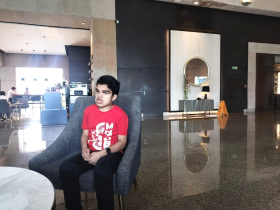
Shaurya Singh
Funding delays have been devastating for children like 13-year-old Shaurya Singh. He died in August after years of waiting for treatment for Hunter Syndrome, a genetic disorder that can lead to organ and brain damage. Diagnosed at age 2, he finally received therapy—funded by a pharmaceutical charity—when he was 9. “By then, his body had already suffered irreversible damage,” says his father, Saurabh Singh. “He passed away five years later. This shows how critical it is to start treatment early. Time is the cruelest enemy.”
The system’s dysfunction meant that only 107 of more than 570 registered lysosomal storage disorder patients are receiving therapy, per data shared by Manjit Singh of the LSDSS. More than 50 of the children have died in three years, including 20 in the last year alone.
Another government shortfall: The limited funds are distributed unevenly. Because drug doses are weight-based, hospitals often prioritize infants whose treatments cost less, leaving older children excluded. “There are over 1,500 SMA patients registered with us, but only four or five have received government aid,” says Archana Panda, co-founder of CureSMA India. “As children grow, costs rise, but support doesn’t. Families travel hundreds of kilometres to reach a centre, only to return empty-handed. The system is stacked against them.”
When Crowdfunding Fails
To help patients who need lifelong, high-cost treatment, the health ministry launched in 2022 a crowdfunding portal to help families raise money for costly therapies. Three years later, it stands as a grim symbol of policy failure. More than 4,000 patients are registered, but the portal has raised less than $4,800—a drop in the ocean compared to the $60,000–$240,000 needed annually per child.
“The portal failed because there are no mechanisms to channel Corporate Social Responsibility (CSR) funds or encourage donations,” says Shirol. Under India’s Corporate Social Responsibility (CSR) law, large companies must spend at least 2% of their average net profits on social welfare projects.
“Billions go into infrastructure projects through CSR, but nothing is set aside for children fighting for life,” Shirol says.
Fighting for the Right to Health
As the system faltered, India’s courts responded. In October 2024, the Delhi High Court ordered the government to create a National Fund for Rare Diseases (NFRD) with $117 million allocated over two years. Instead of complying, the government appealed to the Supreme Court, where the case remains pending.
“Almost a year later, there’s still no interim relief,” says Manjit Singh. “Each month of delay is costing lives.”
The latest hearing, on November 7, 2025, brought no breakthrough. The next one is set for March 2026—another season of waiting for families already running out of time.
Health ministry officials refused to comment on the funding problems. But a senior ministry official pointed to the March 2023 exemption of the drugs from customs duties of 10%, though parents say that the exemption offers little relief when a single drug can cost millions of dollars. The senior official added, “Despite fiscal constraints, the Ministry has plans to raise the rare disease budget to [$117 million] over the next two years.” The ministry’s Press Information Bureau has not responded to questions seeking clarification.
Advocates and experts say these measures barely scratch the surface of what’s needed. “The policy is a fragmented patchwork,” says Panda. “Without a permanent national fund and insurance integration, India’s rare disease framework will keep collapsing under its own weight.”
The Families Who Refuse to Give Up
While courts deliberate and ministries defend, families continue their private battles for survival. Many mortgage homes, sell jewelry, or turn to crowdfunding, yet the costs often remain beyond reach.
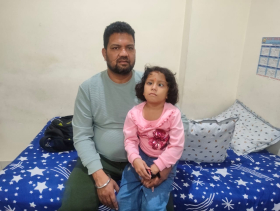
Anil and his daughter, Nitisha.
Delhi businessman Anil Kumar Bisht says his daughter Nitisha, who has Gaucher disease type 3, began regressing within months of when her treatment stopped. “My child went to school for the first time after treatment. But six months after it ended, we are back to fear,” he says. “Now she needs a higher dose as her weight has doubled. We are praying she gets it.”
Across India, parents exchange advice in WhatsApp groups, write letters to officials, and plead for sponsors online. “It feels like we’re competing for our children’s lives,” says Bisht. “Each dose feels like a lottery ticket—one that could save him, or not arrive in time.”
For children like Adrija Mudi, those comparisons offer no comfort. Every month without therapy brings irreversible decline. “She is losing skills she had regained,” her father, Jayanta Mudi, says quietly. “We just want her to live.”
Rupsa Chakraborty is an award-winning health journalist and researcher whose work has appeared in The BMJ, Hindustan Times, The Indian Express, The Times of India, and other publications. She is currently a Commonwealth Shared Scholar pursuing an MSc in global health policy at the London School of Economics and Political Science.
Editor’s Note: This article was published as a voluntary contribution by the journalist for the public good.
Join the 50,000+ subscribers in 170+ countries who rely on Global Health NOW summaries and exclusive articles for the latest public health news. Sign up for our free weekday newsletter, and please share the link with friends and colleagues.
People pass by Mumbai’s King Edward Memorial (KEM) Hospital, one of India’s 13 centers of excellence in rare disease care. Jan. 28, 2017. Dhiraj Singh/Bloomberg via Getty

